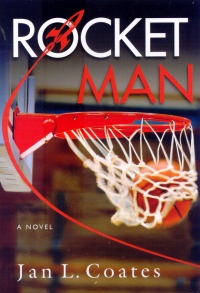| ________________
CM . . .
. Volume XXI Number 9 . . . . October 31, 2014
excerpt:
At the beginning of Rocket Man, Bob Prescott is an eighth grader who thinks of himself as Mr. Invisible. He feels inadequate and overlooked, other than when he is being bullied, and he wishes he could actually become invisible. His passion for basketball, however, leads him to push past his personal insecurities and his fears of the bullies on the team. As he pushes himself to become a speedy "rocket man" on the court, he finds himself becoming more visible to classmates, teachers, family members, and, unfortunately, his bullies, Roy and Kyle. At the same time, Bob's father is fighting cancer, and Bob feels powerless as he watches his dad struggle against what his family calls "the C Monster." In a moment of inspiration, Bob decides to use his passion and newfound visibility as a basketball team member to overcome his sense of powerlessness in the face of cancer. He organizes a fundraiser basketball game to support cancer research. While Bob is discovering his own potential and his newfound sense of self, Roy's nasty bullying behaviour lands him a stint doing community service work with the Pee Wee basketball program that Bob leads. Their forced shared experience leading the Pee Wees gives Bob a new perspective on Roy's personal challenges. Both boys grow because of this interaction and gain an appreciation of the other's strengths, though this section of the book feels underdeveloped. Coates could have spent more time exploring the shift in the boys' dynamic in order to make their eventual friendliness more believable, but, though this narrative shortfall undermines the relationship that develops between Roy and Bob, it doesn't prevent the reader from enjoying the rest of the story, or from receiving the message that everyone struggles and deserves compassion. All problems aren't miraculously cured by the book's end as Bob's father continues to fight cancer, but the book nevertheless ends with a sense of fist-pumping success as Bob leads the charity game entitled "Hoops Heroes 4 Health" to a successful and emotionally satisfying conclusion. Rocket Man is contemporary fiction which follows a conventional linear plot. It appears to be set in a non-specific Canadian town, given mentions of the school's Terry Fox Run and the assignment of Canadian history papers. Because the main character is in the eighth grade, the ideal reader of this book is probably between the ages of 10 to 13. The story is written in first person, and so Bob's problems take on a personal significance for the reader. The audience is encouraged to empathize with the main character's dilemmas, such as his experience of being bullied and the trauma of dealing with his father's illness. Empathy is a central focus in this story. Not only is the reader encouraged to empathize with Bob, but Bob, himself, develops insight into Roy's bullying behaviour, and their dynamic shifts as they both begin to see the other person as a fellow human being rather than a victim or antagonist. Though Kyle doesn't change during the story, Roy's transformation into a more sympathetic character offers a sense of hope that perhaps Kyle, too, can change his bullying ways. The importance of gaining self-confidence also emerges as a central theme. Bob's determination and drive to succeed as a basketball player help to create and sustain his self-confidence as he ultimately becomes not only a "hoop hero" as "Rocket Man," but a community hero as the leader of a successful charity drive. Bob's transformation into someone he is proud to be is shown by his eventual willingness to leave "Mr Invisible" in the dust in exchange for his full-throttle and highly visible identity as "Rocket Man". Bob's evolution creates a satisfying conclusion to Coates' book. Recommended. Devon Galitsky has a literature degree from the University of the Fraser Valley and lives in Chilliwack, BC.
To comment on this title or this review, send mail to cm@umanitoba.ca.
Copyright © the Manitoba Library Association. Reproduction for personal use is permitted only if this copyright notice is maintained. Any
other reproduction is prohibited without permission.
CM Home | Next Review | Table of Contents for This Issue - October 31, 2014 | Back Issues | Search | CM Archive | Profiles Archive |
